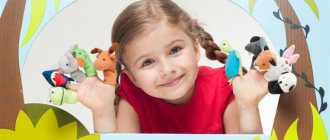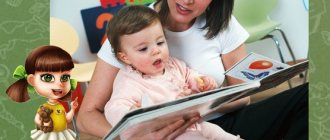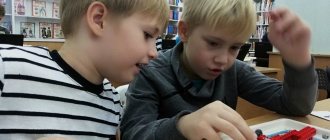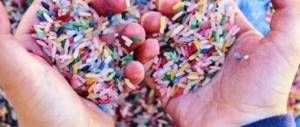“Cognitive and speech development of preschool children” consultation
“Cognitive and speech development of preschool children”
The development of cognitive and speech activity is one of the most important sections of preschool pedagogy and is aimed at the mental development of the child. The better the cognitive and speech activity of children is organized, the higher the guarantee of success in school education.
At home, children spend a lot of time near the TV and computer; often the free time of older preschoolers is devoted to visiting various clubs and studios. Most often, parents brush off children's questions; fiction and encyclopedic literature, even if read, are very rarely discussed. And therefore, the formation of cognitive and speech activity mainly falls on the shoulders of educators.
There are cases when a poor vocabulary leads to aggressive behavior towards others, because a child cannot express in words what he sees, what he knows, what he feels, and the child’s achievements in understanding the world around him will not be noticeable if they are not expressed in his active speech.
Techniques used in formation
cognitive and speech development are traditional:
• Visual - observations, looking at pictures, showing films, slides, presentations.
• Practical - exercises, games, experiments and experiments, modeling, project activities, research activities.
• Verbal – story, reading, questions, conversations, use of literary words.
The main tasks of cognitive and speech activity:
1. Enrich the cognitive sphere of children with information through classes, observations, experimental activities, and speech.
2. Enrich the emotional and sensory experience in the process of direct communication with objects, phenomena, and people.
3. Help organize information about the world around us and form ideas of its integrity.
4. Form a caring attitude towards the world around you, consolidate positive emotions, and the ability to express them.
5. Create conditions that facilitate the identification and maintenance of interests, the manifestation of independence in cognitive and speech activity.
6. Maintain conditions for the development of cognitive and speech processes of preschool children in all types of activities.
It is impossible to develop a child’s speech without including him in cognitive activities, because speech accompanies and improves the cognitive activity of children, making it more focused and conscious.
To properly organize cognitive and speech development, the following areas can be distinguished:
1. The speech of the teacher himself, which has a teaching and educational orientation. The main thing is the quality of language content, which ensures high work results. A preschooler who spends most of his time in kindergarten communicating with the teacher learns a lot from him, including speech culture. The child also perceives our speech as a model. The teacher must speak correctly, without distorting sounds or erasing endings. It is especially important to clearly pronounce long or unfamiliar words introduced into the children's dictionary.
2. Formation of ideas about the world around us. After all, a preschooler encounters new objects and phenomena every day. But the accumulation of knowledge and ideas without appropriate guidance will be superficial or erroneous. Often a child thinks that clouds are cotton wool because they are white, stars are light bulbs because they glow. After all, observing natural phenomena, he independently came to this conclusion. Therefore, the main task of the teacher is to consistently increase children’s stock of knowledge, organize it, and systematize it. The child should receive clear, age-appropriate ideas about surrounding objects, their purpose, qualities, the materials from which they are made, where, by whom, and what they are used for. The child also acquires knowledge about living and inanimate nature, about natural phenomena, their relationships and patterns.
3. Develop curiosity. Curiosity is a quality inherent in all children. It is expressed in an active interest in the world around us, in the desire to examine, touch, and put everything into action. Countless questions testify to the presence of this quality in a child. The teacher’s task is to support the child’s curiosity by organizing classes and observations, trying to answer questions that arise in a timely manner and in an understandable language, directing children’s thoughts to an independent search for an answer and the ability to draw conclusions.
4. Sensory education. Because for a preschooler, knowledge of the world around him begins with sensations and perceptions. The higher the level of their development, the richer the opportunities for understanding the world around them. The content of sensory education includes the development of auditory sensitivity, tactile sensitivity, that is, the ability to distinguish and name the qualities of objects.
5. Game. One of the most effective means of cognitive and speech development of preschool children is play. And if during organized educational activities a child gains knowledge, then during play he has the opportunity to reflect knowledge about the world around him, share this knowledge with friends, and find like-minded people of interest. Certain types of games have different effects on cognitive and speech development.
Role-playing games expand ideas about the world around us and promote the development of verbal dialogue.
Dramatization games contribute to a deeper understanding of the meaning of the works being played and activate speech.
Construction and construction develop constructive abilities, expand knowledge about geometric shapes and spatial relationships.
Didactic games occupy a particularly important place in this work, since cognitive content and mental tasks are a mandatory element in them. By repeatedly participating in the game, the child firmly masters the knowledge with which he operates. And by solving a mental problem in a game, the child will learn to remember, reproduce, and classify objects and phenomena according to general characteristics.
Experimental games are a special group of games that are very effective in solving cognitive and speech problems, and are also interesting and exciting for older preschoolers, because at the same time, they have the opportunity to learn to see a problem, solve it, analyze and compare facts, draw conclusions, and achieve results.
Each group should have an area for the cognitive and speech development of children. This zone covers a variety of content and provides for different types of children's activities. The main principle of its design is accessibility. Everything presented in it is at the complete disposal of children. The material in this zone must necessarily contain: didactic and printed board games of various types, illustrative material, various collections, demonstration material, equipment for experimental activities and experiments, a mini-library.
For preschool children, cognitive and speech development is a complex phenomenon that includes the formation of mental processes. But if the teacher approaches solving the problems of this section competently and creatively, then children will not have problems mastering the tasks.
Consultation for teachers “Development of speech activity in children of senior preschool age”
Tatiana Cherkashina
Consultation for teachers “Development of speech activity in children of senior preschool age”
Preschool age , as is known, is a period of intensive development of the child , and timely acquisition of correct speech, including its active use , is one of the main conditions for the normal psychophysical development of the child , the formation of a full-fledged personality, and preparation for school.
“To learn to speak, you must speak”
M. R. Lvov.
Speech is the most important creative mental function of a person, the area of manifestation of the inherent ability of all people for cognition, self-organization, self-development and construction of one’s personality, one’s world through dialogue with other individuals.
In order for a child to master oral speech in a timely and high-quality manner, it is necessary that he use it as often as possible, coming into contact with peers and adults, i.e., have a certain speech activity . With the normal development of speech, this process occurs unnoticed, by itself, and the pedagogically correct organization of children’s makes it possible to accelerate the formation of speech activity .
The comprehensive development of a child is carried out on the basis of assimilating the centuries-old experience of mankind. This experience comes to children from adults; it is transmitted through language.
development - This is teaching the native language, correct speech, developing verbal communication , expanding the vocabulary, learning retelling. The components of speech activity are the speed of speech reactions both in dialogue and in other situations, the choice of games and gaming hobbies related to speech, speech imagination , and mastery of the language system at a certain level.
Mastering coherent speech is not only the ability to correctly construct a sentence, namely a chain of words united by one verb.
The subject-developmental environment of the group should contribute to the development of children's speech : book, theater, speech corners , story games to familiarize children with social reality.
We must strive to ensure that children independently name objects, their characteristics, actions, and are able to classify them. To do this, you can design a speech box , where various subject and subject pictures are placed. Children will be able to independently compose riddles, descriptions, and stories based on pictures.
You should use finger games and games with origami elements more often in your work (Children make cups for their fingers and then play the game): “We have five assistants in reserve every time,
They shave, glue and wash, knead, iron, clean.
I will cover you with hats, my fingers are all my friends.
Increasing the level of communication skills, expanding vocabulary, developing the grammatical structure of speech, improving sound culture, including sound pronunciation and general speech skills , practical awareness by children of the elements of language, development of coherent speech (monologue and dialogic)
occurs in classes with games of the following content:
“Find (invent)
words with sound..."
(let's collect the words in a basket,
“Catch the words if you hear the sound in them...”
or Firecracker
“Help me find a place for sound in a word”
, (sound tracks,
“Who will win - vowels or consonants in a word....? Count which sounds are more?”
“How many sounds do you hear in the word...?”
, “Determine the sequence of sounds in a word”
,
“Come up with a word based on the sound (syllable...”).
“Let’s divide the words into parts and count how many we got!”
(cones, cubes, claps, steps, buttons on Slogovichka,
"Magic Transformations"
or rhymes
(exercises on word formation and inflection)
.
Quiet, quiet, like in a dream,
Falls to the ground... (Snow.)
Fuzzes keep sliding from the sky - Silver...
(Snowflakes.)
To the villages, onto the meadow Everything is falling...
(Snowball.)
Here's fun for the guys - More and more...
(Snowfall.)
Everyone is running in a race, Everyone wants to play...
(Snowballs.)
Like Dressed up in a white down jacket...
(Snowman.)
Nearby there is a snow figure - It's a girl -
(Snow Maiden.)
In the snow, look - With a red breast...
(Bullfinches.)
As if in a fairy tale, as in a dream, Decorated the whole Earth...
(Snow. ) “Choose a related word”
: Dragonfly - dragonflies, dragonfly;
Winter – winter, wintering, winter quarters; Summer – summer, annual, perennial; Leaf – leaves, leaf fall, deciduous; Table – tables, table top, dining room; House – homely, brownie, homely; Ant - ants, anthill, ant; Day – days, daytime, noon; Hour - clock, sentry, hour; Head – head, heads, tadpole. “Come up with a sentence using a given word or using pictures”
,
"Finish the sentence"
: It became dry outside because...
It's dark at night because...
It started to rain, so...
Rivers and lakes freeze at night because...
Children water carrots in order to...
We'll go for a walk if...
“So that the words are not lost”
(drawing up sentence diagrams,
"Locomotive"
(distribution of proposals,
“And that’s how it was!”
(compilation of stories based on a series of plot pictures)
.
"One day…." (compiling a story according to a given plan or plot picture) “Let’s color the words!” (selection of epithets)
Hedgehog, hedgehog, where were you walking?
Where did you lose the thorns? Run to us quickly, hedgehog. We will help you now! “Find something similar!”
(selection of synonyms,
"Stubborn Donkey"
(selection of antonyms,
“If a letter gets lost...”
(selection of paronyms)
, etc.
Telling riddles:
The sun rises early in the morning. It draws rays and gives us warmth.
Snow in summer! Just laughter! Snow is flying around the city, why doesn't it melt? (Poplar fluff)
This little one has legs. This one has crumbs. The eyes of a ladle And the ears as long as C the kitchen dish (baby elephant)
.
The story “What are hands for?”
E. Permyak Petya and his grandfather were great friends and loved to ask each other different questions. The grandfather once asked his grandson: “Why, Petenka, do people need hands?” “And to play with a ball,” answered Petya. - And for what else? - asked the grandfather - To hold a spoon - And also? - To pet the cat. - And what else? - To throw pebbles into the river. How would you answer Petya’s grandfather’s question?
A fairy tale is one of the most accessible genres of fiction children The language of the tale is simple and accessible. By retelling a fairy tale, the sound expressiveness of speech, diction, phonemic perception, and vocabulary are formed. Children love to show tabletop and finger theaters based on fairy tales. Also, it is easier for children to complete a math task with their favorite fairy-tale characters.
Memorizing poetry is a tedious process, so it is useful to use techniques such as: “tell it in pairs”
,
“draw a poem”
,
“sing”
.
Sketching poetry is an excellent assistant for solving many educational problems. For each word or small phrase, a picture is created. Looking at these diagrams - drawings, the child easily reproduces textual information.
K. D. Ushinsky wrote: “Teach a child some five words unknown to him - he will suffer for a long time and in vain, but connect twenty such words with pictures, and he will learn on the fly.”
Exercises for the development of speech creativity in children : 1. Compose a story based on observed actions. 2. Compose a story based on several plot pictures. 3. Compose a story based on the text and picture you listened to. 4. Compose a story based on one plot picture. 5. Compose a story from memory. 6. Compose a story using symbols. 7. Compose a story using diagrams. 8. Compose a story based on natural objects. 9. Compose a story using subject pictures. 10. Compose a story using the given words. 11. Compose a story with the replacement of any one detail or episode in the presented text. 12. Compose the end of the story started by the teacher 13. Compose a story on a given topic. 14. Writing fairy tales.
It is useful to play games with a globe and a geographical map. Here not only speech develops , but also horizons. The child becomes a traveler, he conquers seas and countries, remembers the names of cities, flora and fauna of other countries.
You can make interesting glasses of different geometric shapes. Having put them on, children find objects of the same shape and come up with different names for these objects.
Proverbs and sayings are genres of oral folk art. They reflect various aspects of people's lives and everyday life. They broaden children's and help them learn better about folk art. In Russia they believe that a saying is a flower, and a proverb is a berry. In your free time, you can play guessing proverbs, dramatizing them, or the “Finish the Proverb”
.
Many words in the Russian language have not one, but two or three, sometimes a dozen or more meanings. There is a pattern: the more often a word is used in speech, the more polysemantic it is. Polysemantic words form a semantic unity. The interpretation of their meanings necessarily reveals a certain similarity between the objects they designate and the phenomena of the surrounding world. The word "nose"
in great demand.
It was needed by people and animals, as well as by boats, ships and boats, which began to proudly plow the waters of the seas, oceans, lakes and rivers with their bows. The word "tail"
is useful to all animals, birds, as well as trains, planes, rockets and comets.
Working on the polysemy of words ensures speech development and contributes to the formation of the qualitative side of children’s vocabulary, the development of free speech , and the ability to consciously choose the most appropriate linguistic means for a given statement. Ultimately, this work serves to develop the level of general speech culture .
Of particular importance are literary and speech festivals dedicated to the work of children's writers. The main task of such holidays is to give joy from meeting with your favorite works, and at the same time, speech problems .
Memorizing poems, designing baby books, holding speech quizzes , competitions, and tournaments help develop children's thinking and teach them to reflect basic emotional states.
The speech development of an older preschooler is determined by the degree of formation of his knowledge, skills, cognitive and social motives, needs and interests, as well as other mental formations that form the basis of his personal culture. A high level of speech achievements gives him the opportunity to realize both social and intellectual activity among peers and adults. Expanding the content of communication needs directs the child’s attention to new aspects of reality: knowledge of the human world and relationships with others, the natural world, objective and practical and artistic reality. New communication needs determine the need for new means that should help realize new goals.
Conclusion: The development of creative abilities will awaken the hidden potential, reserves, originality and talent inherent in any child. However, the ability to create, including speech creative ability, will develop most successfully only if its development is promptly provided with appropriate incentives and optimal conditions of the environment in which the child is located.





